平成28年12月07日 水曜日号
“師走にぎわい 平成24年”

十二月に入ると何となく
気ぜわしくなってくる。
何といっても一年のしめくくりである。
いろんな気持ちを内にかかえながら
人々はあわただしく行き来する。
街も人々の気持を映して
落ち着かない日が続く。
(脇阪 克二)
"December bustle"(2012,by Katsuji Wakisaka)
When December arrives,
We get busy somehow.
It's the end of the year,
People are hurrying to and fro,
Busy with their affairs.
The town bustled with activity,
All December long.
| English translation by LI XIAO XIAO |
"Décembre mouvementé"(2012, par Katsuji Wakisaka)
Quand Décembre arrive, pour une raison quelconque,
nous sommes encore plus occupés.
La clôture des dossiers approche à grands pas.
Tout en prenant sur soi-même,
Les gens multiplient les aller-retours.
Influencée par le cœur de ses habitants,
La ville voit se poursuivre les journées agitées.
| Traduction française par Jean-Baptiste Fauvel Matsumoto |
"忙碌的十二月"(2012, 胁阪 克二)
一到十二月便匆忙起來。
年底將近,
街上的人們行色匆匆,各懷心思。
城市顯得格外繁忙。
| 中译 : 李 瀟瀟 |
→こちらのテキスタイルデザイン商品
(Textile products with this pattern)
平成28年12月03日 土曜日号
“山茶花 平成24年”
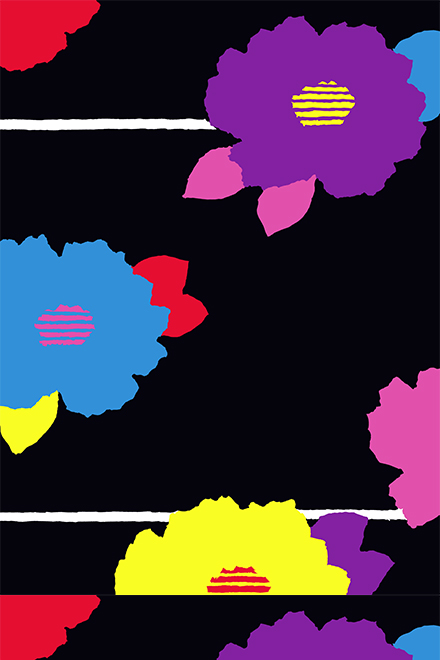
寒くなってきたなぁと思うころ山茶花は咲き始める。
垣根などで見かけるが注目されることの少ない花だ。
それだけ日本の暮らしに溶けこんでいるのだろう。
近づいてよく見るとたたずまいのいい花だと思う。
(脇阪 克二)
"Sazanka / Camellia sasanqua"(2012,by Katsuji Wakisaka)
Camellia sasanqua begins to bloom during autumnal cold.
They would be unnoticed but bloom silently on the hedges.
It is so that blend into our Japanese daily life.
Take a closer look, they standing like jade---
A slender and beautiful figure.
| English translation by LI XIAO XIAO |
"Le camélia d'automne"(2012, par Katsuji Wakisaka)
Au moment où le froid automnal se fait ressentir, le camélia d'automne commence à fleurir.
Cette fleur que l'on voit souvent sur des murs mais qui n'attire presque jamais l'attention.
À tel point qu'elle fait partie intégrante de la vie d'un japonais.
En y regardant de plus près, il s'agit d'une bien jolie fleur.
| Traduction française par Jean-Baptiste Fauvel Matsumoto |
"山茶花"(2012, 脇阪 克二)
氣候變涼的時節,山茶花開始綻放。
於民家的庭園圍籬靜靜開花的山茶,
雖非備受矚目的存在,
卻已然深深滲入日本人的日常生活之中。
走進細細觀賞,定能品味到它們的寧靜典雅。
| 中譯 : 李 瀟瀟 |
→こちらのテキスタイルデザイン商品
(Textile products with this pattern)
平成28年11月30日 水曜日号
“大和錦 平成21年”

秋が深まって霜や時雨のたびに一段と赤さを増していく
紅葉の中をひとすじの川が流れる。
凋落した真っ赤なもみじ葉が水の流れに身を任せていく。
王朝絵巻を思い起こさせる雅な錦の世界が広がっていく。
(脇阪 克二)
"Yamato nishiki / Golden autumn"(2009,by Katsuji Wakisaka)
Autumn has set in.
Every time it freezes or drizzles, leaves turning red little by little.
A river flows through the maple trees,
Fallen leaves spiral downward and float away on the it...
This golden autumn sight,
Gorgeous like an imperial-court picture scroll.
| English translation by LI XIAO XIAO |
"Yamato-Nishiki"(2009, par Katsuji Wakisaka)
L'automne s'installe et à chaque fois qu'il gèle ou qu'il bruine, une rivière s'écoule à travers les érables rougissants.
Les feuilles d'érables rouges tombées s'en remettent corps et âme au courant de l'eau.
La mode des sublimes brocarts, qui a amené le règne des emaki, s'ouvre au monde.
| Traduction française par Jean-Baptiste Fauvel Matsumoto |
"大和錦"(2009, 胁阪 克二)
秋漸深,每逢寒露或時雨,紅葉也更深一層。
溪水從如霞似錦的紅楓中穿然而下,
凋落的紅葉委身于流水。
這般雅景猶如昔日王朝畫卷,在眼前鋪陳開來。
| 中译 : 李 瀟瀟 |
→こちらのテキスタイルデザイン商品
(Textile products with this pattern)
平成28年11月25日 金曜日号
“洛中洛外図 平成28年”


京都の市街(洛中)と郊外(洛外)
の景観や風俗が描かれた屏風。
寺社仏閣や祭、庶民の暮らしまで
細かく描き込まれている。
全体に雲を配して構成され
いろんな場面を華麗に表現している。
今も京都にある風景と重なっていて
想像力をかきたて 見あきることがない。
(脇阪 克二)
"Rakuchū-Rakugaizu / Sights in and around Kyoto"(2016,by Katsuji Wakisaka)
Folding screens of Rakuchu rakugai-zu, or Sights in and around Kyoto,
Depicted the town area (inner Kyoto) and suburbs (outer Kyoto).
Views of shrines and temples, scenes of festivals and lives of common people are all painted in details.
With the arrangement of clouds in composition,
It creates a magnificent illustration of many vivid sights.
This textile held forth the charms of Kyoto, association between ancient and modern.
You'll never get tired of it...
| English translation by LI XIAO XIAO |
"Rakuchū-Rakugaizu / Plan intérieur-extérieur de Kyoto"(2016, par Katsuji Wakisaka)
Il s'agit d'un paravent où sont dessinés
les paysages et les coutumes du centre et de la banlieue de Kyoto.
Y sont également dessinés avec précision
les temples et sanctuaires de la ville, les festivals ou les petites gens.
Structuré dans son entier avec l'ajout de nuages,
Il représente avec magnificence une multitude de scènes.
Juxtaposées avec des scènes d'un Kyoto beaucoup plus contemporain,
elles stimulent notre imagination.
Impossible de s'en lasser...
| Traduction française par Jean-Baptiste Fauvel Matsumoto |
"洛中洛外圖"(2016, 胁阪 克二)
描繪京都的市區街道、郊外的景色以及風俗的屏風。
京都的神社寺廟,四季節慶,庶民生活等一覽無遺地呈現其中。
在霭霭金雲掩映下,華麗生動地彩描了古都熱絡繁榮的景象。
同時激發觀者的想像力,將圖中所繪的場景與當代京都今昔重疊,不爲疲也。
| 中译 : 李 瀟瀟 |
→こちらのテキスタイルデザイン商品
(Textile products with this pattern)
平成28年11月23日 水曜日号
“紅葉狩り 平成22年”
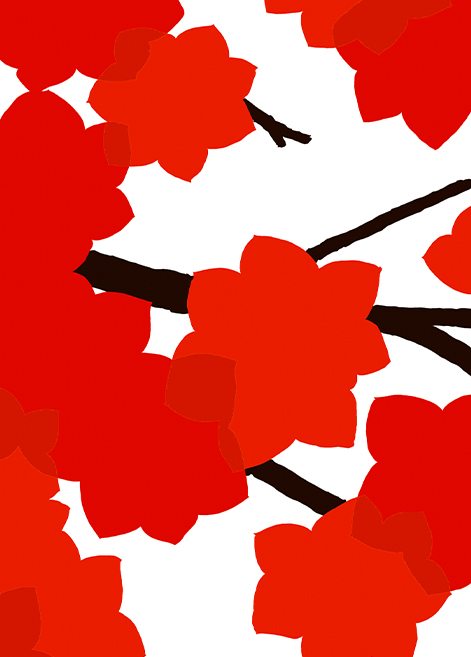
晩秋の陽をあびて光り輝く無数の赤い葉の
連なりを見ていると、心が高揚してくる。
やがて来る冬を前にして、最後の力を振りしぼって
燃焼する生命の力に圧倒される。
あそこのお寺の紅葉はもう始まっただろうか、
今どれくらい赤くなっているだろうかと、
気になって落ち着かなくなる。
(脇阪 克二)
"Momiji gari / Leaf peeping"(2010,by Katsuji Wakisaka)
Innumerable red maple leaves,
Illuminated by the late autumn sun, touched me.
Used up all their strength,
Burst into flames before winter comes, amazed me.
Did the leaves of that temple begin to turn red?
To what extent have they tinged?
Leaf peeping, sweep me off my feet.
| English translation by LI XIAO XIAO |
"À la chasse aux érables rouges"(2010, par Katsuji Wakisaka)
À la vue des feuilles d'érables aux rouges infinis brillant dans le ciel nocturne automnale, mon cœur s'exalte.
Juste avant l'arrivée imminente de l'hiver, elles joignent leurs dernières forces en une explosion de vie. Les feuilles d'érables de ce temple ont-elles commencé à changer de couleurs?
À quel point ont-elles rougis?
Nos cœurs s'emballent et il est impossible de se calmer.
| Traduction française par Jean-Baptiste Fauvel Matsumoto |
"賞紅葉"(2010, 胁阪 克二)
瞭望那沐浴在晚秋陽光中的無數紅葉,內心盎然。
在冬天來臨之前,使勁最後一絲力氣,燃燒成一蓬火焰。
這源于生命力的爆發讓我折服。
今年那座寺廟的紅葉是不是已經開始漸紅了?
不曉得現在紅到什麽程度了?
教我在意,不能靜待。
| 中译 : 李 瀟瀟 |
→こちらのテキスタイルデザイン商品
(Textile products with this pattern)
平成28年11月19日 土曜日号
“実りの秋 平成23年”

りんご、みかん、ぶどう、かき。
収穫の秋。
豊かな実りに感謝。
(脇阪 克二)
"Autumn harvest"(1996,by Katsuji Wakisaka)
Apples, mandarins, grapes, persimmons.
Hooray! The autumn harvest.
Let us be grateful to the great harvests.
| English translation by LI XIAO XIAO |
"Récolte automnale"(1996, par Katsuji Wakisaka)
Pommes, mandarines, raisins, kakis.
L'automne des moissons
Soyons reconnaissants pour de si bonnes récoltes.
| Traduction française par Jean-Baptiste Fauvel Matsumoto |
"秋之實"(2010, 胁阪 克二)
蘋果,柑橘,葡萄,柿子。
收獲之秋。
對豐盛的果實充滿感激。
| 中译 : 李 瀟瀟 |
→こちらのテキスタイルデザイン商品
(Textile products with this pattern)
平成28年11月16日 水曜日号
“水屋 平成27年”
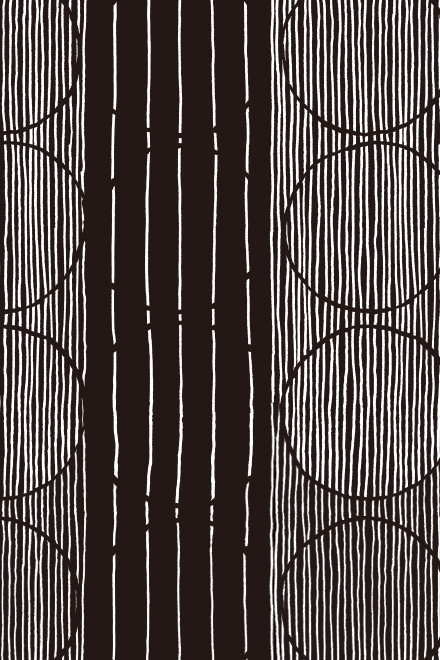
茶室に付属したものに水屋がある。
細い竹を並べてつくった棚に
茶道具や茶わんなどが並べられている。
整然とした たたずまいは
潔く凛としている。
(脇阪 克二)
"Mizuya"(2015,by Katsuji Wakisaka)
There is an area attach to a tea ceremony room,
Called mizuya, lit. “water house”.
On a storage shelf made of fine bamboo,
The tea bowls and other utensils are kept.
Clean and ordered,
All in a commanding appearance.
| English translation by LI XIAO XIAO |
"Mizuya"(2015, par Katsuji Wakisaka)
Dans chaque salle de cérémonie de thé
se trouve un espace de rangement appelé Mizuya.
Sur une étagère fabriquée en bambou fin,
Des ustensiles de cuisine et des chawan, bols à thé, y sont rangés.
Cet air solennel est pur et vertueux.
| Traduction française par Jean-Baptiste Fauvel Matsumoto |
"水屋"(2015, 脇阪 克二)
日式茶室旁擺放茶具的空間稱爲「水屋」
將細竹排成一排製成的架子上
有序地擺放著茶碗和各式茶具
整潔凜然
| 中譯 : 李 瀟瀟 |
→こちらのテキスタイルデザイン商品
(Textile products with this pattern)
平成28年11月12日 土曜日号
“紅葉がさね 平成23年”
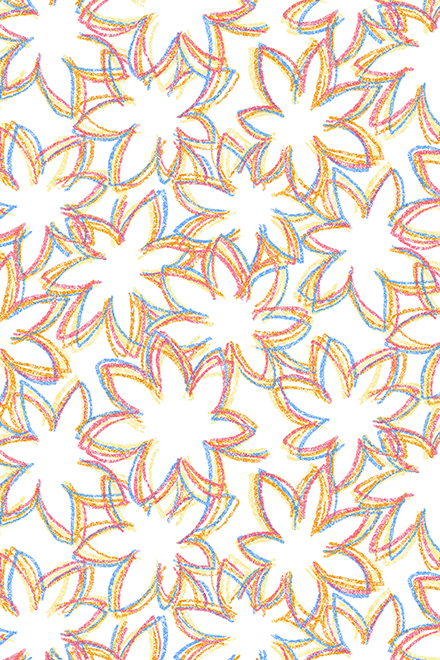
秋晴れの中、光り輝く山もみじ。
濃い赤から黄色まで彩り豊かに山を染め分ける。
散ったもみじは重なり合い響き合って
美しいハーモニーをかなでる。
(脇阪 克二)
"Maple leaf jigsaw"(2011,by Katsuji Wakisaka)
Another autumn day, sunny and clear.
Maple mountain in the sun,
Being painted into yellow reds and oranges.
Fallen leaves, overlap one another,
Performing a natural harmony of landscape.
| English translation by LI XIAO XIAO |
"Monticule de feuilles"(2011, par Katsuji Wakisaka)
En plein cœur de l'automne, les feuilles d'érables brillent dans les montagnes.
Allant du rouges au jaune, elles drapent richement les montagnes.
Les feuilles tombées s'empilent les unes sur les autres en formant une harmonie esthétique.
| Traduction française par Jean-Baptiste Fauvel Matsumoto |
"紅葉層層"(2011, 脇阪 克二)
秋日晴天,楓葉在陽光下層層閃耀
從深紅到金黃,秋葉將山林染成漸變色彩
落在地上的楓葉也層層疊疊
譜成一部和諧的深秋交響曲。
| 中譯 : 李 瀟瀟 |
→こちらのテキスタイルデザイン商品
(Textile products with this pattern)
平成28年11月09日 水曜日号
“七五三 平成23年”

子どもの無事な成長を願い
三・五・七才の十一月十五日に
神社に参拝する。
長寿を祈り千歳飴をいただく。
この千歳飴の袋の絵が
とても印象的。
(脇阪 克二)
"Shichi-go-san / children’s festival"(1996,by Katsuji Wakisaka)
Shichi-go-san (lit. "Seven-Five-Three") is a children’s festival in Japan for three- and seven-year-old girls and three- and five-year-old boys, held annually on November 15 to celebrate the healthy growth of children.
On this day, people visiting shine,
Chitose-ame (lit. "thousand year candy") that symbolizes longevity is given to children.
The package design of chitose-ame is so impressive for me.
| English translation by LI XIAO XIAO |
"Shichi-go-san"(1996, par Katsuji Wakisaka)
la fête des enfants Afin de prier pour la bonne croissance de leurs enfants, Les japonais se rendent au sanctuaire Le 15 Novembre avec leurs enfants âgés de 3, 5 et 7 ans. On prit pour une longue vie et on reçoit des bonbons Chitoseame. Le dessin du paquet de ces bonbons est très impressionnant.
| Traduction française par Jean-Baptiste Fauvel Matsumoto |
"七五三"(2010, 胁阪 克二)
11月15日是日本的“七五三”兒童節.
這一天3歲和5歲的男孩以及3歲和7歲的女孩,
會跟父母到神社參拜,祈願身體健康,順利成長。
參拜結束後,父母給孩子們買象征長壽的千歲糖。
千歲糖的包裝圖案另我印象深刻,
這個紋樣設計靈感也是來源于此。
| 中译 : 李 瀟瀟 |
→こちらのテキスタイルデザイン商品
(Textile products with this pattern)
平成28年11月05日 土曜日号
“立冬 平成25年”

冬の気配がただよい始めるこの季節。
お茶の世界では炉開きが行われる。
春から秋にかけて使われていた風炉にかわり、
炉を開き釜をたく。
炉が切られた茶室は
壁の侘助とともに
緊張感のある美しさにみちている。
これから冬に向かう立冬のころ。
(脇阪 克二)
"Rittō / First day of winter"(2013,by Katsuji Wakisaka)
Winter is coming.
Robiraki, in the world of Chado, usually takes place in this cold season.
Robiraki, or opening of the hearth, is a Japanese tradition of tea preparation.
The kama or iron kettle is placed in Ro or a sunken hearth , while it is placed on a brazier from spring to autumn.
In the tea room, Ro act a subtle beauty in harmony with camellia wabisuke on the wall.
Winter is coming.
| English translation by LI XIAO XIAO |
"Premier jour de l'hiver"(2013, par Katsuji Wakisaka)
L'hiver approche. Robikari, une fête traditionnelle liée au Sadō (L'art du thé), est organisée à cette période. La bouilloire en fonte est placée dans un Rō, foyer creusé réservé à cet effet, au dessus d'un brasier du printemps jusqu'à l'automne. Le foyer crépitant et les wabisuke de camélia créent dans le salon de thé une beauté subtile et étriquée. Le jour annonciateur d'un hiver en approche.
| Traduction française par Jean-Baptiste Fauvel Matsumoto |
"立冬"(2013, 胁阪 克二)
立冬喚來冬日氣息,
日本茶道也迎來“開爐”的時節。
關閉茶室裏從春天到秋天使用的風爐,打開地爐。
地爐與茶室牆上的晚秋山茶交相輝映,
凜然而美。
立冬後,進入寒冷的冬季。
| 中译 : 李 瀟瀟 |
→こちらのテキスタイルデザイン商品
(Textile products with this pattern)
平成28年11月02日 水曜日号
“秋深し 平成25年”
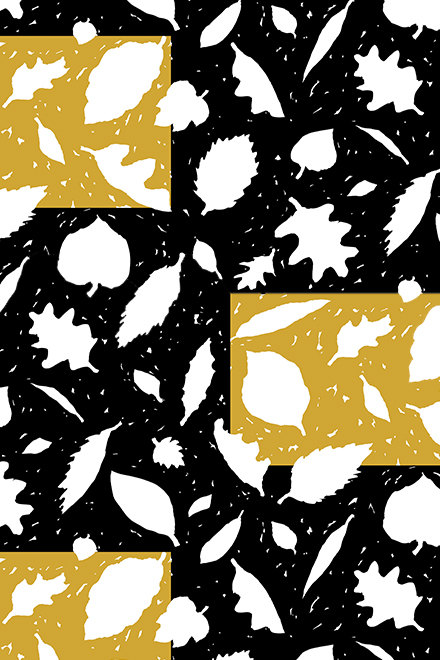
冷たい木枯らしが吹くとサーッと枯葉が落ちてくる。
いろんな形の葉っぱが地面に秋の模様を描いていく。
毎年くりかえされる風景だが
1年がもうすぐ終るんだという想いが深くなる。
(脇阪 克二)
"Akifukashi / Autumn leaf kaleidoscope"(2013,by Katsuji Wakisaka)
The wintry blast howl,
Dying leaves fall, arrange themselves freely on the ground.
A kaleidoscope of leaves, a paint of autumn.
Year after year,
Reminding us another year draws to a close.
| English translation by LI XIAO XIAO |
"À la recherche de l'automne"(2013, par Katsuji Wakisaka)
Lorsque ce vent d'hiver froid commence à souffler
Les feuilles mourantes tombent fébrilement.
Une multitude de feuilles aux différents formes
Dessinent au sol les motifs de l'automne.
Il s'agit d'un phénomène qui se répète tous les ans mais
La sensation que la fin de l'année s'approche se renforce.
| Traduction française par Jean-Baptiste Fauvel Matsumoto |
"深秋"(2013, 胁阪 克二)
秋風冷,枯葉飄零。
形狀各異的落葉,
在地面描繪出深秋的模樣。
此景年年俱映,
讓人深感歲末的臨近。
| 中译 : 李 瀟瀟 |
→こちらのテキスタイルデザイン商品
(Textile products with this pattern)
平成28年10月29日 土曜日号
“けんらん 平成24年”
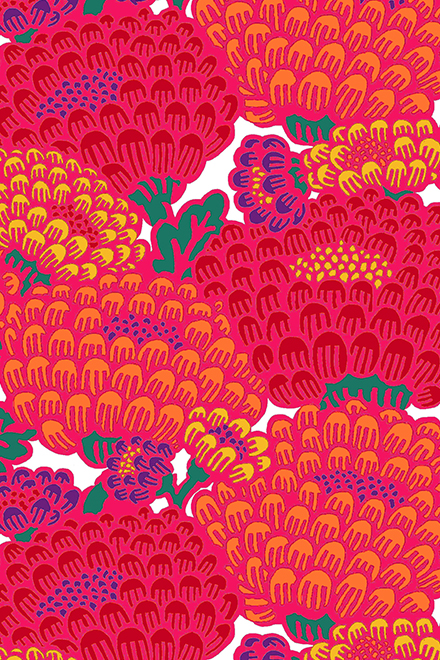
花びらの一枚一枚がびっしりと
空間をうめつくし絢爛豪華に咲き乱れる花。
イメージの中の花は
現実の世界のものよりいっそう輝いて花を競う。
僕の心の中にはこんな濃密な世界がある。
(脇阪 克二)
"Kenran / Dazzling"(2012,by Katsuji Wakisaka)
Flowers bloom, dazzling and gorgeous,
The space is fully stuffed with petals.
Flower bloom,
Far more luscious than that in the real world.
It’s the rich flowery world in my mind.
| English translation by LI XIAO XIAO |
"Kenran / Éblouissant"(2012, par Katsuji Wakisaka)
Les fleurs éclosent, pétales après pétales,
Recouvrant l'espace magnifiquement.
Dans ce tableau vivant,
Nous rivalisons avec ces fleurs en brillant encore plus fort que dans le monde réel.
Il existe également dans mon cœur une facette si riche.
| Traduction française par Jean-Baptiste Fauvel Matsumoto |
"絢爛"(2012, 胁阪 克二)
花瓣層層疊疊,充盈整個空間。
花開絢爛,競相吐豔,
那姿態比現實世界中更爲絢爛奪目。
我心中有此一圃濃密的世界。
| 中译 : 李 瀟瀟 |
→こちらのテキスタイルデザイン商品
(Textile products with this pattern)
平成28年10月25日 火曜日号
“織部 平成27年”
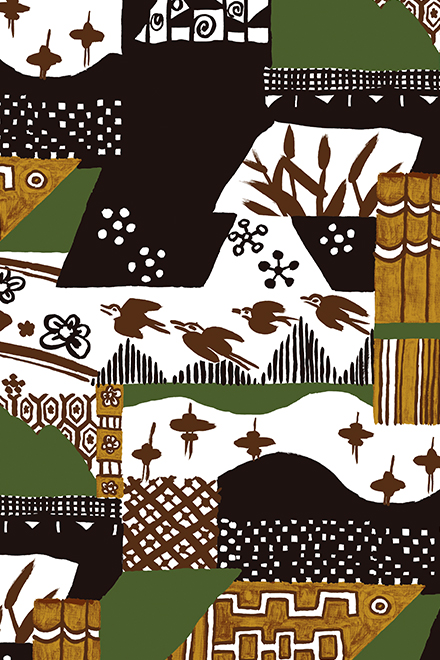

千利休の弟子であった大名茶人
古田織部の指導で創始された。
織部好みの奇抜で斬新な形、
文様の茶器が大量につくられた。
渋いものが好まれる日本の陶器
としては珍しく大胆なもので
その印象は強烈。
傾き者、古田織部にふさわしい面白さがある。
(脇阪 克二)
"Oribe ware"(2015,by Katsuji Wakisaka)
Oribe is a visual style named after Furuta Oribe, a pupil of Sen no Rikyū (the foremost tea master), under whose guidance it was first produced.
The unique shapes and vivid patterns were manufacture in large quantities according to Oribe’s taste.
Oribe ware introduced a truly new and bold vision to a ceramics tradition that had previously favored somber, monochrome designs.
As a “kabuki mono” (who dares to be different), Oribe create a unique aesthetic sensibility to express his fascinating personality.
| English translation by LI XIAO XIAO |
"Oribe"(2015, par Katsuji Wakisaka)
Oribe est un style visuel nommé d'après Furita Orobe, un élève de Sen no Rikyū (grand maître de cérémonie de thé), qui fut réalisé pour la première fois sous ses ordres.
Avec des formes uniques, des ustensiles de thé à motifs divers furent produits en masse en accord avec Oribe.
Ses créations furent présentées comme des œuvre rares et audacieuses, en contraste avec les céramiques traditionnelles, plus sombres et simplistes.
En tant qu'artiste original, Oribe a créé sa propre sensibilité afin d'exprimer sa personnalité fascinante.
| Traduction française par Jean-Baptiste Fauvel Matsumoto |
"織部燒"(2015, 胁阪 克二)
織部燒是由千利休的弟子——著名茶人古田織部創始的茶陶。
古田織部指導生産出的大量茶碗,
與樸素的傳統茶器相比,形狀圖案大膽奔放,
爲日本陶器帶來一陣強烈的觀感沖擊和自由豁達的新風。
織部燒也表現了古田織部個人的自由、豁達之風格。
| 中译 : 李 瀟瀟 |
→こちらのテキスタイルデザイン商品
(Textile products with this pattern)
平成28年10月22日 土曜日号
“どんぐりころころ 平成23年”

どんぐりは丸くて、ころころしていて、
手に持っても気持ちいいし、見ていてもかわいい。
どんぐりが落ちていると、その上を見て、
どんな葉で、どんな形か見てみる。
そして自分が好きな感じだったら、
拾って帰って植えておく。
冬を越して、
芽が出てきた時は、うれしいですよ。
(脇阪 克二)
"Acorn roll"(2011,by Katsuji Wakisaka)
Little acorns, tiny and round,
Hold one in hand, smooth to touch.
Little acorns, fallen by the tree,
Just look up to see the shape of their leaves.
Pick one or two,
Take them gently home with you.
What a joy to see they sprout,
After the next cold winter pass.
| English translation by LI XIAO XIAO |
"Petit gland"(2011, par Katsuji Wakisaka)
Les glands sont ronds et lisses. Ils sont mignons et doux au toucher. Lorsqu'un gland tombe, on regarde en l'air Pour voir le type de feuilles et leur forme. Et si l'arbre en question nous plait, On ramasse le gland pour le planter chez soi. Une fois l'hiver passé, Quelle joie de voir sortir de terre cette petite pousse.
| Traduction française par Jean-Baptiste Fauvel Matsumoto |
"橡子圓溜溜"(2011, 胁阪 克二)
橡子這種圓溜溜的萌物,
長得小巧可愛。
拿在手裏把玩,
光滑的外殼,微涼的觸感。
這些小家夥啪嗒,啪嗒從頭頂的深秋落下,
擡頭看看它葉子的形狀。
再拾起一顆喜歡的,
帶回家種起來,
越冬之後,萌出嫩芽。
讓人無比欣喜。
| 中译 : 李 瀟瀟 |
→こちらのテキスタイルデザイン商品
(Textile products with this pattern)
平成28年10月19日 水曜日号
“花あそび 平成24年”
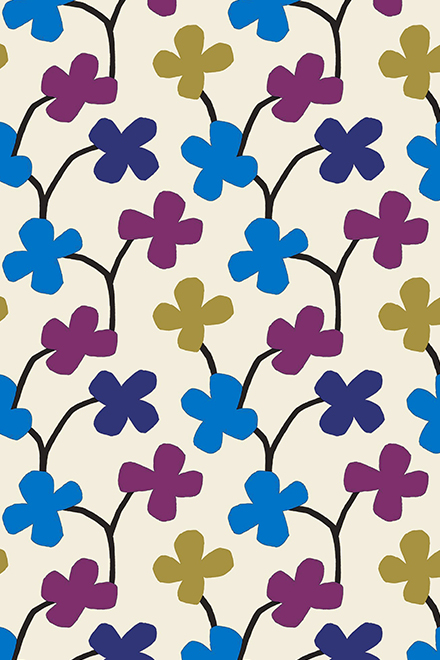
花があそんでいる。
開いたり 閉じたり
茎をゆらせて おどったり
お互いにあいさつしたり
花は遊んでいる。
花がいっせいに こちらを
見ている時もある。
花はひとつの場所に
じっとしているが
実は活発に体を動かして
太陽の光を受けようとしている。
花も遊んでいる。
(脇阪 克二)
"Flowers play"(2012,by Katsuji Wakisaka)
Flowers play,
They open out and close up,
They dance, waving their slender stalks,
They greet each other, by bowing.
Flowers play,
Sometimes they look towards me or stand still.
Sometimes turn their heads to the bright, kissed by the sunlight.
Flowers play, enjoying every moment of it.
| English translation by LI XIAO XIAO |
"Jeu des fleurs"(2012, par Katsuji Wakisaka)
Les fleurs s'amusent. Elles s'ouvrent et se referment. Elles dansent en agitant leur pédoncule. En se saluant tour à tour, Les fleurs s’amusent. Il arrive parfois qu'elles regardent par ici tous en cœur. Les fleurs se tiennent immobile à un seul endroit Mais en réalité, elles bougent activement En essayant de capter les rayons du soleil.
Les fleurs s'amusent, elles aussi.
| Traduction française par Jean-Baptiste Fauvel Matsumoto |
"花遊"(2012, 脇阪 克二)
小花們在嬉戲
綻開,閉合
扭動腰肢,跳起了舞
點頭鞠躬,相互問好
時而一齊扭頭朝向我
小花們看似長在固定的地方
其實不停精力充沛地活動身體
盡情接受陽光的恩賜
小花們在嬉戲
| 中譯 : 李 瀟瀟 |
→こちらのテキスタイルデザイン商品
(Textile products with this pattern)
平成28年10月15日 土曜日号
“木の実 平成14年”
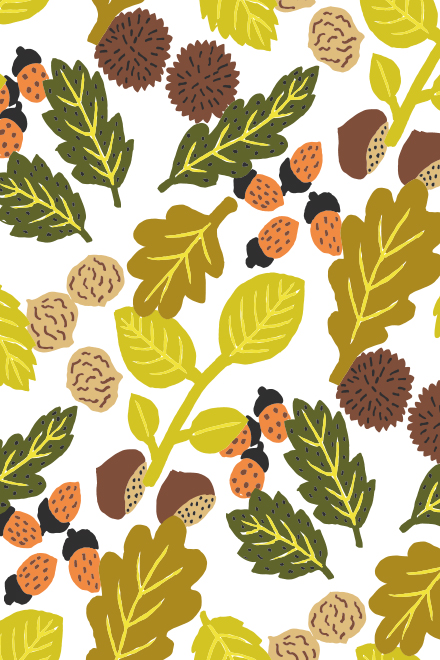
森へ行こう。
どんな葉っぱに会えるだろう。
木の実やどんぐり、栗もあればいいな。
いろんなものに出会いながら
自分を探すために森に来ているのかもしれない。
(脇阪 克二)
"Konomi / Nuts and leaves"(2002,by Katsuji Wakisaka)
Come into the forest,
What leaves will we meet?
I hope there will be nuts, acorns and chestnuts too.
So full of life, autumn natural beauty,
A walk of wonderful encounter,
A walk for discover ourselves.
| English translation by LI XIAO XIAO |
"Konomi / Les noix"(2002, par Katsuji Wakisaka)
Allons dans la forêt. Mais quelles feuilles allons-nous rencontré? J'espère qu'il y aura des noix, des glands et aussi des châtaignes. En faisant la rencontre d'une multide de choses, nous sommes peut être venus dans la forêt pour nous chercher nous-mêmes.
| Traduction française par Jean-Baptiste Fauvel Matsumoto |
"果實"(2002, 胁阪 克二)
去森林吧!
遇見深秋的樹葉和果實,
興許還有橡子和栗子。
去森林吧,
遇見這樣那樣的果實,
或許也是爲了探尋自己。
| 中译 : 李 瀟瀟 |
→こちらのテキスタイルデザイン商品
(Textile products with this pattern)
平成28年10月12日 水曜日号
“野菊 平成18年”
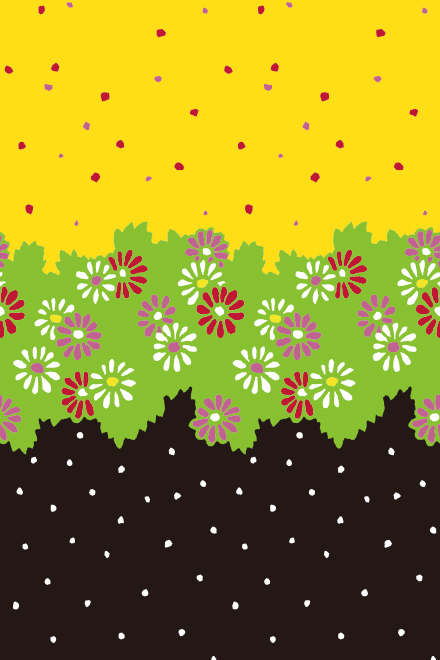
野菊には派手さはないが素朴で楚楚(そそ)とした美しさがある。
野原の風景に溶けこみながら、
日の光や土のにおいとともにしっかりと根付いている。
(脇阪 克二)
"Nokiku / Wild chrysanthemums"(2006,by Katsuji Wakisaka)
Wild chrysanthemum,
Never flashy.
Her beauty of simplicity and elegance,
Distinctive in the autumn field.
Deeply rooted in the sunlight and earthy smell.
| English translation by LI XIAO XIAO |
"Chrysanthèmes sauvages"(2006, par Katsuji Wakisaka)
Les chrysanthèmes sauvages ne sont pas tape-à-l'œil mais il existe chez elles une simplicité et une élégance. En se fondant dans les plaines, Elles s'enracinent fermement, accompagnées des rayons du soleil et de l'odeur de terre.
| Traduction française par Jean-Baptiste Fauvel Matsumoto |
"野菊"(2006, 胁阪 克二)
野菊不嬌豔,美得清淑閑雅。
它融于秋的原野,
紮根在日光和泥土的芬芳裏。
| 中译 : 李 瀟瀟 |
→こちらのテキスタイルデザイン商品
(Textile products with this pattern)
平成28年10月09日 日曜日号
“運動会 平成23年”

気持ちをワクワクさせる勇壮なマーチが
聞こえてくる。
空は秋晴れで雲ひとつない。
ピストルの音が響き、歓声がこだまする。
子どもの元気な姿が、赤や白の帽子とともに
目に飛び込んでくる。
かけっこがはじまる。
玉入れが、騎馬戦が、組立体操が、
いろんな競技が、次から次へと繰り広げられる。
(脇阪 克二)
"Sports day"(2011,by Katsuji Wakisaka)
March for sports day,
Excites me under the clear autumn sky.
Among the sound of starting gun and hooray for the players,
Sports day is bustling with activity.
Here you see energetic children,
Keep on burning bright with their red or white hats.
Sprint, tamaire(ball-toss / beanbag toss), mock cavalry battle,
and group gymnastics...
So exciting a sport day.
| English translation by LI XIAO XIAO |
"Fête des sports"(2011, par Katsuji Wakisaka)
On peut entendre les pas rythmés propre à la fête des sports,
sous un ciel automnal sans aucun nuage.
Un coup de pistolet résonne et les hourras s'élèvent.
Défilent devant nos yeux des enfants plein d'énergie,
portant des chapeaux rouges et blancs.
La course à pied débute. Suivie du tamaire, kibasen et du Kumitaisō…
Les compétitions se succèdent les unes après les autres.
| Traduction française par Jean-Baptiste Fauvel Matsumoto |
"運動會"(2011, 胁阪 克二)
秋高氣爽,晴空不挂片雲,
某處傳來運動會振奮人心的進行曲。
發令槍響,加油聲,喝彩聲不絕于耳。
孩子們朝氣蓬勃的身影,
隨躍動的紅白雙色的體操帽一起映入眼簾。
短跑,擲豆袋,騎馬大戰,團體操……
各種競賽項目一一拉開帷幕。
| 中译 : 李 瀟瀟 |
→こちらのテキスタイルデザイン商品
(Textile products with this pattern)
平成28年10月05日 水曜日号
“寒露 平成25年”
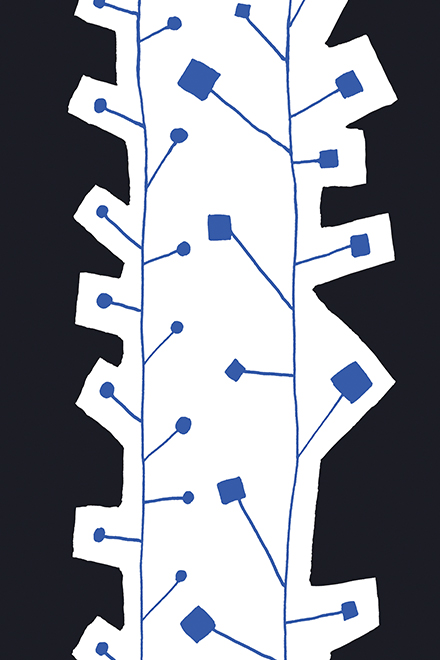
晩夏から初秋にかけて野草に冷たい露がやどり
朝晩は肌寒く秋の深まりを感じ始める。
草木についた丸い露が朝日にきらきらと光って美しい。
これから冬を迎える前のさわやかで気持のいい日が続く。
(脇阪 克二)
"Kanro / Early winter dew"(2013,by Katsuji Wakisaka)
Cold dew, hanging on the wildflowers,
Through late summer to early autumn.
Chill in the air, days and nights, as fall deepens.
Grass with twinkling dew drops,
Under the shimmer of the morning sun.
It’s the best season before winter comes.
| English translation by LI XIAO XIAO |
"Rosée hivernale"(2013, par Katsuji Wakisaka)
Rosée hivernale, se déposant sur les herbes sauvages,
de la fin de l'été jusqu'au début de l'automne.
Une brise souffle, jour et nuit, alors que les jours d'automne s'allongent.
De l'herbe s'écoule la rosée Sous les premiers rayons du soleil matinal.
C'est la meilleure saison avant la venue de l'hiver.
| Traduction française par Jean-Baptiste Fauvel Matsumoto |
"寒露"(2013, 胁阪 克二)
夏末初秋的季節,
野草上結起冰涼露珠,
晨間夜裏的寒氣也透出漸濃的秋意。
寒露棲在草木上,晶瑩剔透,
最是一年秋高氣爽的好時節。
| 中译 : 李 瀟瀟 |
→こちらのテキスタイルデザイン商品
(Textile products with this pattern)
平成28年10月01日 土曜日号
“森の散歩 平成27年”
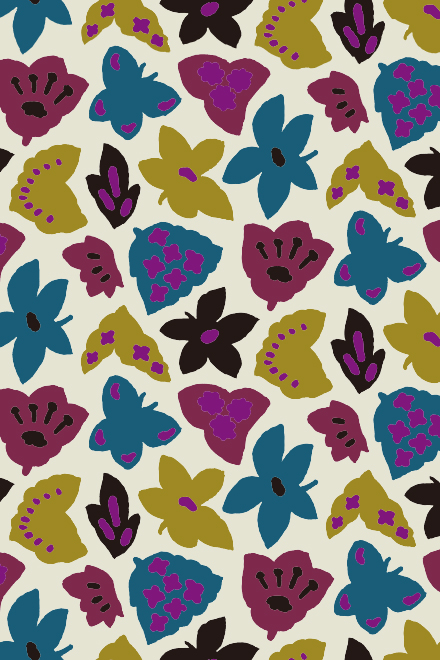
秋が深まってきた一日
森へ散歩に出かける。
木もれびを あびながら
落葉をふみしめて 歩いていく。
いろんな草や葉、きのこや苔などを
目に入れながら
久しぶりの森の散歩を楽しむ。
心が解放され 体も軽く
なってくる。
(脇阪 克二)
"Forest walk in autumn"(2015,by Katsuji Wakisaka)
The forest takes me for a quiet walk in the autumn day.
The sun dully shone through the tree branches.
Stepping on those beautiful dry leaves,
I look down the plants,
leaves, and mushrooms and mosses,
a moment of harmony, an instant of calm.
Forest walk in autumn, clear my troubled mind.
| English translation by LI XIAO XIAO |
"Balade en forêt"(2015, par Katsuji Wakisaka)
Nous sortons faire une promenade en forêt,
En cette période de plus en plus automnale.
Sous la lumière perçant les feuillages des arbres,
Nous marchons sur un canapé de feuilles mortes.
Tout en observant les plantes, feuilles, champignons et mousses,
nous profitons de cette balade en forêt. Le cœur libéré et le corps léger...
| Traduction française par Jean-Baptiste Fauvel Matsumoto |
"森林散步"(2015, 胁阪 克二)
秋意漸濃,
去森林裏散步。
陽光透過樹葉間隙傾灑,
我踏著落葉前行,
目光投向林中的秋草,樹葉,蘑菇,苔藓。
這是一場久違的漫步,
治愈我,讓我氣暢身輕。
| 中译 : 李 瀟瀟 |
→こちらのテキスタイルデザイン商品
(Textile products with this pattern)







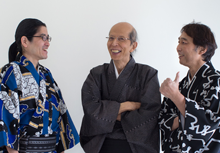

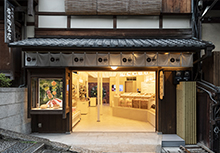

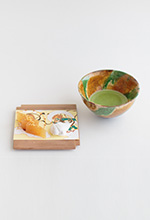
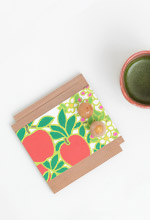
 お問い合わせ窓口
お問い合わせ窓口